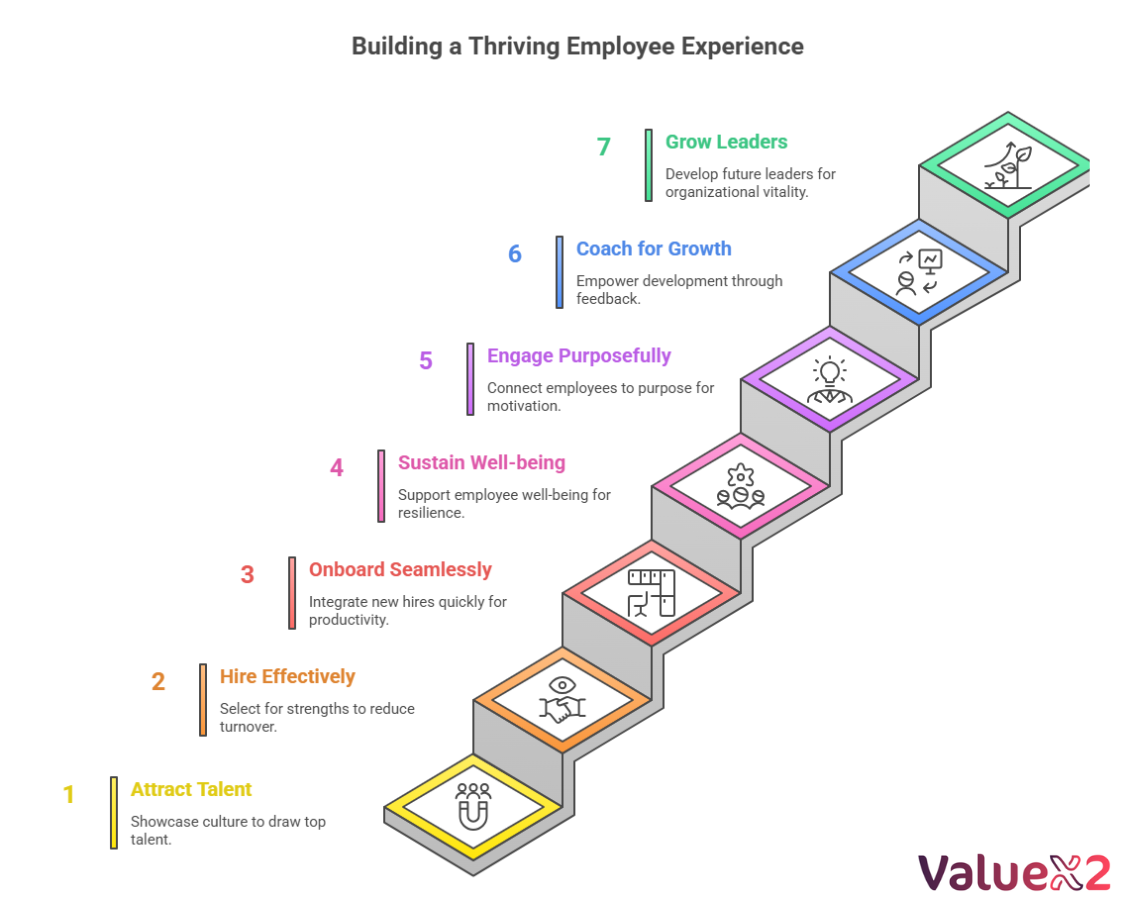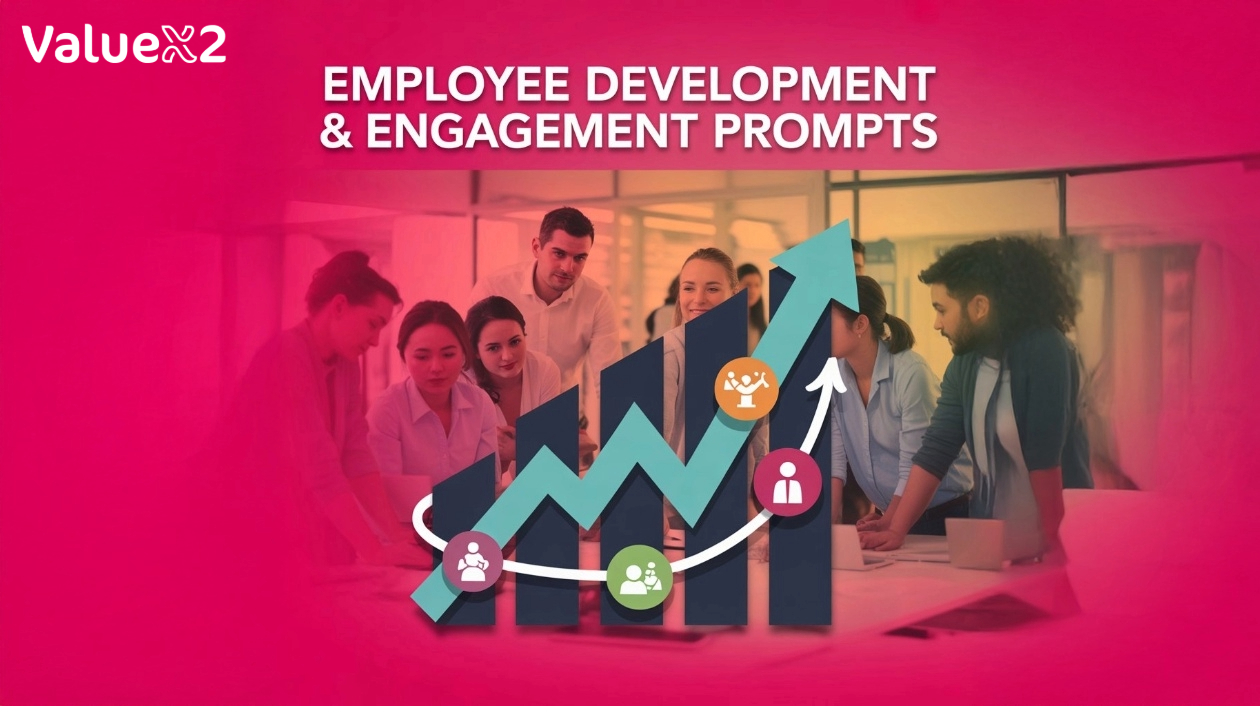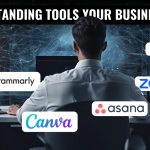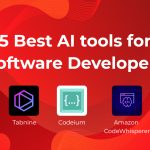If you were afraid AI would take your job, we have good news: an IBM study reveals 87% of executives expect AI to augment, not replace, job roles, freeing people for higher-value work. What should you do? Find out the best use cases of these prompts for HR and stay tuned for more!
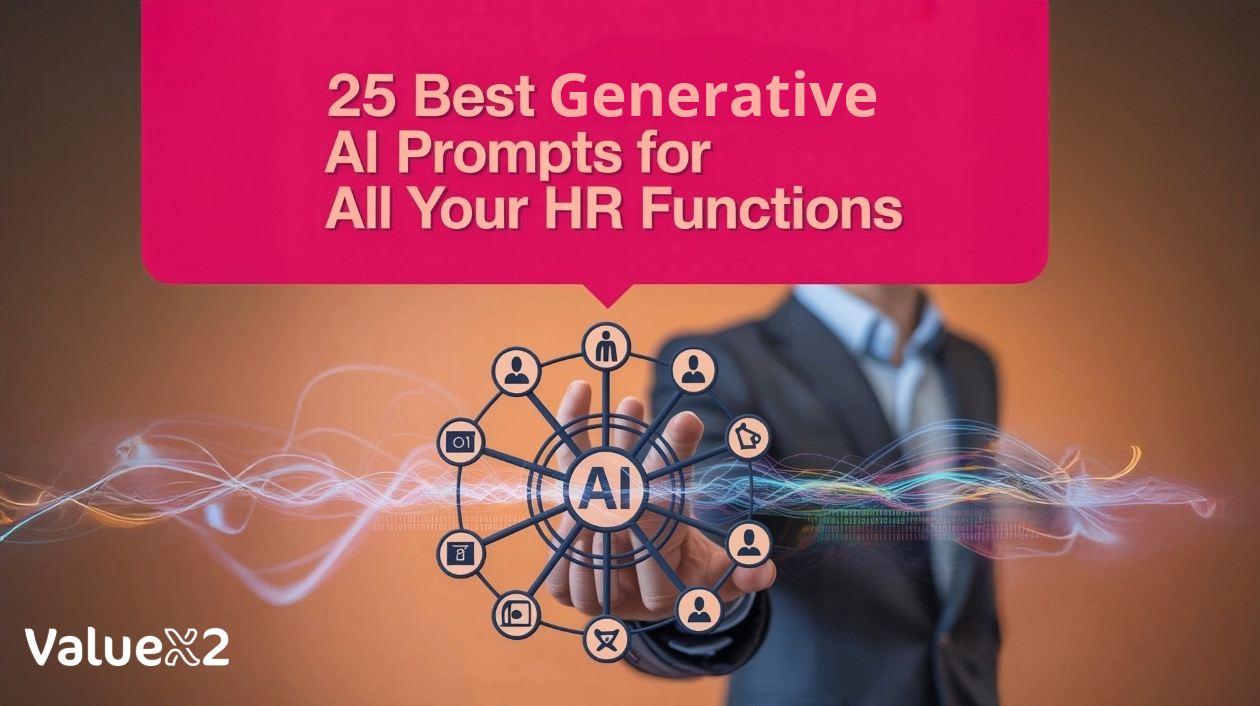
The common perception of AI in HR rarely matches the reality. While it is easy to say AI is all about automating transactional tasks and speeding up administrative processes, as you have pointed out, the real value is getting HR professionals out of the little bits of routine, administrative work, so they can do strategic, human-focused, true HR work.
The truth is, and this has been further confirmed through publications like the Harvard Business Review, many HR teams are suffering from the administrative burden of too much paperwork, approvals, and repetitive tasks. These administrative responsibilities lead to burnout for top-performing talent, distracting valuable time and energy from their actions that truly do make a difference in employee engagement, employee development, and employee retention.
There is also an appetite for this change, which is already present in the workforce. The percentage of employees who are excited to use AI to help them was steadily (64%) enthusiastic about change. Employees are excited about getting rid of this “grunt work” to focus on strategic and creative endeavors.
This is not about replacing talent; it is about augmenting talent. You can thoughtfully expand the utility of human-centered HR talent through the use of AI. Let’s see the best and proper use case of AI.
What Actually Makes a Good HR Prompt?
It can be so hard to figure out ways to implement AI in HR. But to get high-quality, reliable results from tools like ChatGPT or Gemini, your prompt needs three key ingredients. Think of it as the O-C-F Framework:
- Objective: Let the AI do what you want it to do in clear terms. Is it writing, summarizing, analyzing, brainstorming, or generating? Be precise.
- Context: Give the AI the necessary background information. This is the role, company culture, target audience, most pressing challenges, and any data the AI will need to work with. The more relevant the context you give, the less generic the output will be.
- Format: Describe precisely how you would like the output to be organized. Do you require a table, a list of bullet points, a formal email, or a block of Mermaid code? Specifying the format prevents having to redo the response subsequently.
ChatGPT Prompting Tips
- Always use the latest version: The jump in quality between AI model versions (e.g., from ChatGPT-4 to 4o) is enormous. Using the most powerful, current model pays dividends in the quality of your output.
- Iterate and Refine: Don’t anticipate perfection in your first attempt. Use your initial prompt as a stepping stone. Use follow-up commands to add to the AI’s response and edit it. This method of “prompt chaining” is most effective in obtaining advanced results.
- Give a Persona: For communications tasks, instruct the AI who to be. For instance, begin a prompt with: Be a friendly, empathetic HR manager. This allows the AI to take on the right tone and style.
How AI can Help HR in Making the Employee Journey Better?

As we move through 2025, the interplay between GPT models and comprehensively designed prompts is renewing every single thing about the employee journey. From day one,AI can help create a tailored plan to welcome a new starter. As the employee progresses, managers can use AI to find the best offerings for training or projects to support their career aspirations. The technology can also help leadership identify and remedy organizational issues, like burnout, before they occur on a team–wide level. At the end of the day, it helps create a better overall workplace focused on the success and wellness of individuals.
Why Wrong Prompts Create Problems Across HR Functions?
Generative AI (GenAI) can do so much in HR. It is surprising how it can create Boolean strings, rate cover letters, write nurture emails, and even simulate flight-risk predictions, as long as you supply it with context, constraints, and voice. Blunt prompts (“Find me great developers”) inflate applicant volume without the right coverage, causing issues across Talent Acquisition, HR Operations, and Learning & Development processes.
-
- Talent Acquisition wastes hours processing the same resume, over and over again.
- HR Operations gets flagged for reports riddled with errors, just because requirements were screened inappropriately upstream.
- Learning & Development can’t envision personalized plans because onboarding notes are inconsistent.
- Employee Experience programs miss critical signals at the outset of relationships that lead to unnecessary churn.
- People Analytics teams can spend more time cleaning than analysing, and delivering strategic insights too late.
The prompts below – 25 in total, categorized into five functional groups – provide a solution to those problems, one by one. Each prompt is in the form of a short paragraph that you can cut and paste directly into ChatGPT, Gemini, or any generative AI tool. A follow-up paragraph follows each prompt that details why it will work and what knobs you could pull for your environment. We always recommend leveraging AI tools for HR Analytics and Data-Driven Decision-Making, the only reason? because it significantly enhances your team’s capabilities.
1. Candidate Discovery & Attraction
| Topic | ChatGPT Prompt Example | Why It Works |
| Boolean Blueprint | Create a Boolean search string for mid-level Python engineers in London with 3-6 years of experience, requiring “Django” OR “Flask,” and explicitly excluding “PHP” OR “WordPress.” Provide one version for LinkedIn Recruiter and a second, separate version for a Google X-Ray search. | This instantly translates your needs into the precise syntax for different platforms. More importantly, it prevents ‘silent filter errors’ where a poor string lets irrelevant candidates through, ensuring a higher-quality longlist and a more efficient top-of-funnel process. |
| Community Sourcing | Identify eight active and welcoming Slack or Discord communities where data-science professionals are currently discussing projects and sharing knowledge. For each, provide an invite link, primary time-zone, an estimate of weekly post volume, and any rules for entry. | The most passionate talent often congregates in niche communities. This prompt uncovers new, high-quality talent pools beyond saturated job boards and provides the activity metrics needed to know where to invest your outreach time effectively. |
| Outcome-First Job Ad | Rewrite the job description that I’ve attached. Begin with a great headline and one sentence that says, “In your first year, you will…” Emphasize concrete results and contributions, not duties. Eliminate all the corporate buzzwords and catchphrases, and conclude with a great question that elicits a response. | This method draws high-achieving “builders” driven by impact rather than a laundry list of responsibilities. It directly addresses high-achievers, enhances mobile readability, and employs a last question to screen for candidates with true interest. |
| Personalized Outreach | Act as a senior tech recruiter. Write five distinct LinkedIn messages for candidates on GitHub. Each message must be highly personalized, mentioning the candidate’s last public code commit by file name and explaining why that specific work is relevant to our open [Role Title] position. | Generic emails get a response from high-level talent at near zero. Mentioning something in particular that they’ve done (e.g., their work on the auth_service.go file) shows you’ve taken the time to do your homework, shows respect for their work, and makes it exponentially more likely you’ll get a response. |
| Market Comparison | Make a comparison table for Poland and Portugal as future cybersecurity talent centers. The columns to include are: Median Total Compensation (USD), Average English Fluency Score (CEFR level), Percentage of Talent Open to Remote Work, and Average Visa Processing Time for Non-EU nationals. | This provides a board-ready snapshot of data in minutes, not weeks. It equips leadership with the quantitative information required to make key strategic decisions on expansion globally, cost-to-hire, and geographical diversity without a multi-week research study. |
HR Tip: Frame your prompts around OKRs (Objectives and Key Results). Instead of asking for “interview questions,” ask for interview questions that will help us assess a candidate’s ability to achieve this Key Result: Launching three new product features per quarter. This aligns your hiring process directly with business goals.
2. Screening & Short-listing
| Topic | ChatGPT Prompt Example | Why It Works |
| Five-Minute Fit Filter | Create five knockout questions to be included on an initial screening questionnaire for a senior UX designer. The questions must evaluate portfolio depth, proficiency of Figma shortcuts, and inter-team storytelling experience. For each question, state clear pass/fail criteria. | This helps you build a powerful asynchronous screening process. It filters out clear misfits automatically, freeing up your and your hiring manager’s calendars to focus only on high-potential candidates who have already cleared a quality bar. Effective prompts like these could be further strengthened by exploring the implementation of better Agile HR practices. |
| Resume Summarizer | Condense the provided resume into a clean, six-bullet summary for a busy hiring manager. The structure should be: two core technical skills, one metric-based accomplishment (e.g., “Increased user retention by 15%”), one leadership story, and two signals of potential culture fit. | Hiring managers are overloaded. This prompt creates a standardized, digestible summary that highlights what matters most. It gives them quick clarity and gives you back hours of your life otherwise spent manually paraphrasing documents. |
| Cover Letter Review | Act as a hiring manager. Review the cover letter below and provide a structured analysis. Rate it Red, Yellow, or Green on four criteria: Craft, Clarity, Brevity, and Culture-fit. For any item not rated Green, provide one actionable suggestion for how the candidate could improve. | This turns a subjective “gut feeling” into structured, tangible data. The specific feedback is also invaluable for nurturing “silver medalist” candidates, building a strong talent pipeline for future roles. |
| Polite Rejection Email | Compose a polite rejection letter to a marketing interviewee who performed well in an interview but did not have direct SaaS experience. Mention a particular strength from the interview dialogue, offer a free online growth-marketing course or tool that they would find useful, and ask them to connect on LinkedIn and apply again in the future. | The way you reject candidates embodies your employer brand. A polite, assistive closing maintains your reputation and makes a “not now” candidate a future hire, customer, or referral source. |
| Offer Confidence Meter | Consider the following situation: Our proposal is [Amount], the salary expectation difference of the candidate is [Amount], and the notice period of the candidate is [X weeks]. We also evaluate the counter-offer risk as [high/medium/low]. Predict the offer acceptance probability as a percentage and suggest two different mitigation strategies that we could use. |
This data-based prediction offers an advance warning system. It provides your staff with lead time to schedule alternative prospects or anticipate issues with your first pick ahead of a promising lead being unnecessarily lost, and averts last-minute rushes.
|
To give you a better idea of how these prompts would work, here’s a screenshot, and you can see the difference.
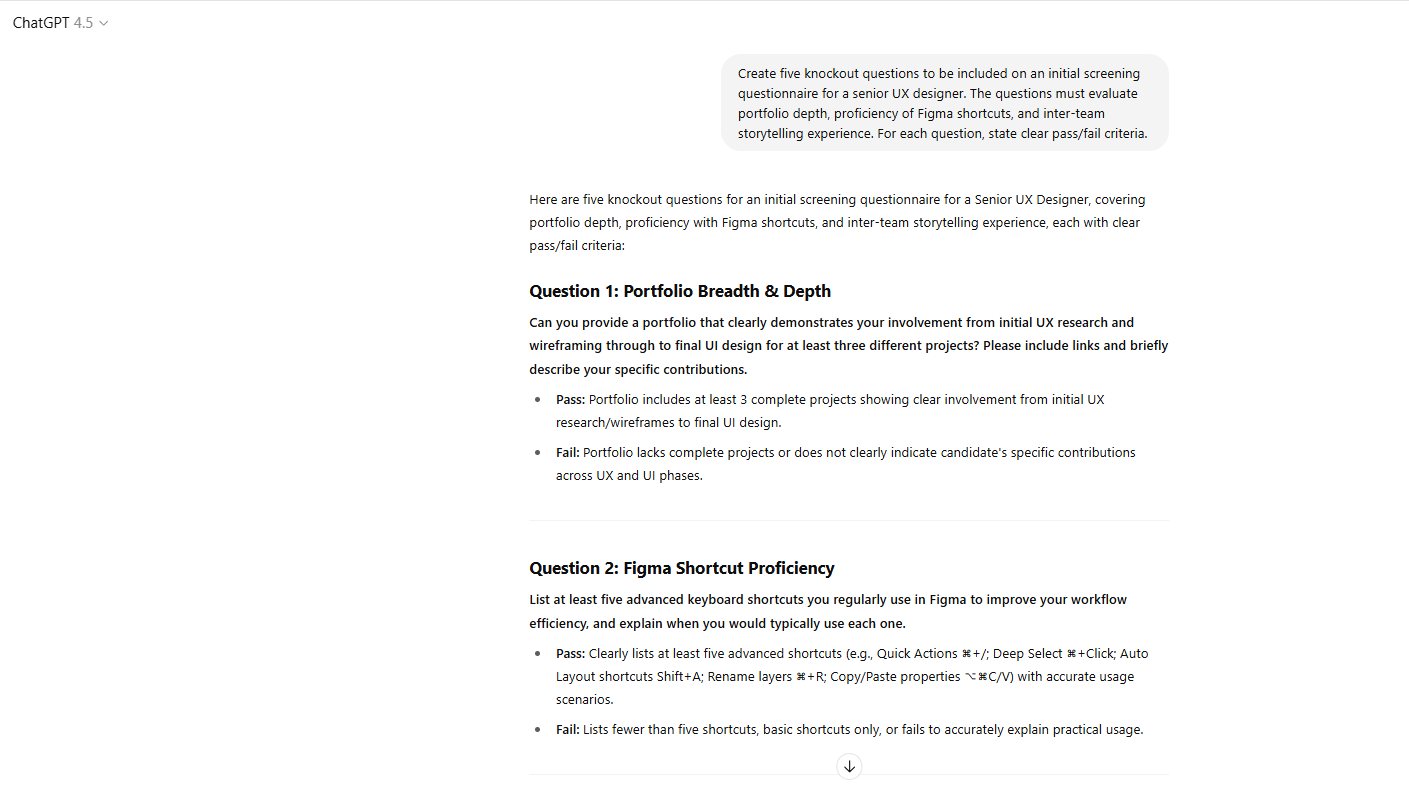
3. Interview Excellence
| Topic | ChatGPT Prompt Example | Why It Works |
| Remote-Work Questions | Create four behavioral interview questions that will uncover how a candidate manages independent decision-making, task prioritization in an asynchronous setting, and excellent working relationships with no in-person interaction. | Remote-first companies live or die by written clarity, self-direction, and trust. These questions test those specific, critical competencies directly, rather than making assumptions based on past co-located work experience. |
| Values-Based Scorecard | Take our five company values (listed below) and turn them into a systematic interviewer scorecard. For each value, delineate 2-3 positive and negative behavioral indicators, design a 1-to-5 rating scale, and develop two follow-up probe questions to drill deeper. | A common, objective rubric is your best protection from “halo and horns” bias. It measures all candidates by the same yardstick, accelerates post-interview debriefs, and provides a defensible audit trail for compliance. |
| Mini-Project Generator | Develop a 45-minute technical task for a React developer position. The project is to create a sortable data table by retrieving data from a public API. Define explicit acceptance criteria, a basic 4-point grading scale (e.g., Functionality, Code Quality, UI, Completion), and two plagiarism safeguards. | A time-boxed, realistic project mimics the work and unveils a candidate’s actual problem-solving process. It generates equitable, similar artifacts without requiring a whole weekend of volunteer work, which honors the candidate’s time. |
| Candidate Questions Coach | Create three strong questions that we are hoping our dream candidates will ask *us*. These should indicate a candidate’s attention to our team’s culture for autonomy, the frequency and quality of feedback in our organization, and the actual routes for career growth here. | The questions a candidate asks are as revealing as the answers they give. Proactively preparing for these questions shows transparency and attracts mature talent who are focused on genuine, long-term growth, not just shiny perks. |
| Warm Welcome Agenda | Create a clear, one-page interview agenda from the following schedule using a warm, motivational, and plain-English tone. Include a brief section at the end with a tension-reducing tip to calm candidate nerves and a note that we want them to do well. | Your clear, inviting agenda significantly increases show-up rates, minimizes candidate anxiety, and delivers a strong, people-oriented impression of your employer brand before the very first interview is underway. |
4. Employee Development & Engagement
| Topic | ChatGPT Prompt Example | Why It Works |
| 90-Day Growth Map | Create a comprehensive 90-day personal development plan for a new product manager. Structure it by month. For each month, outline one on-the-job objective with a clear success metric, one mentoring checkpoint with their assigned buddy, and one formal training module to complete. | This gives instant structure and clarity to a new employee. It incorporates the successful 70-20-10 model of learning (70% on-the-job, 20% social, 10% formal) that is directly attributed to quicker ramp-up times, increased engagement, and better long-term retention. |
| Micro-Learning Curator | Be a Learning & Development expert. Suggest five high-quality, 10-minute-or-less learning materials (articles, videos, or interactive quizzes) that develop stakeholder-management skills for mid-level engineers. Suggest the best order in which to complete them in order to get the most impact. | Bite-sized content honors busy schedules and possesses a greatly increased completion rate compared to long courses. Presenting a coherent learning progression makes the knowledge stick and compound, speeding up the acquisition of skills. |
| Stay-Interview Script | Create an active stay-interview template for managers to conduct with their direct reports. Have 6 open-ended questions about career development, appreciation, workload balance, alignment with the mission, and future goals. Provide a basic template to record answers and action items. | Stay-interviews are a powerful tool to uncover disengagement risks before they become resignation letters. This prompt helps you systemize the process, allowing you to address friction and retain your top performers proactively. |
| Engagement Pulse Craft | Create a five-question quarterly employee pulse survey to assess psychological safety, role clarity, and manager support. Use a five-point Likert scale for each. Also, include one powerful, open-text question: “If you had a magic wand, what is the one thing you would change about working here?” | Regular micro-surveys provide leading indicators of your culture’s health. The data is perfect for creating leadership dashboards that correlate dips in engagement with business performance, enabling data-driven interventions. |
| Peer Recognition Writer | Create three distinct, 60-word peer-recognition “shout-outs” for our company Slack channel. Each one must link a specific colleague’s recent behavior directly to one of our company values (e.g., “Customer Obsession”). Make the tone celebratory and sincere. | Timely, specific, value-based praise is a massive morale and culture amplifier. This prompt helps managers and peers give meaningful recognition without it feeling like a chore, reinforcing the behaviors you want to see more of. |
5. HR Analytics & Continuous Improvement
| Topic | ChatGPT Prompt Example | Why It Works |
| Speed Benchmark Analyst | Analyze our time-to-hire data (pasted below) and compare it against the latest SaaS industry medians. Create a table that highlights any stage in our funnel that is over 20% slower than the benchmark. For each slow stage, suggest one potential root cause and one practical, low-effort fix to test. | This powerful prompt moves your team from looking at “not great” charts to creating a concrete action plan. It turns raw data into a clear list of measurable experiments for process improvement, fostering a culture of continuous learning. |
| Bottleneck Visualizer | Generate a plain-text Mermaid code for a hiring funnel diagram. The stages are: Application, Screen, HM Interview, Panel Interview, Offer, Accepted. Mark any stage transition that takes longer than an average of seven business days in orange. | A one-look graphic instantly highlights where your process is breaking down. Mermaid code is a universal standard that can be dropped directly into tools like GitHub, Confluence, or Notion to create a live, updating visual without needing a designer. |
| Quality-of-Hire KPIs | Define four key quality-of-hire KPIs for our product development roles. For each KPI (e.g., “90-Day Performance Score,” “First-Year Regrettable Attrition”), provide the precise formula for calculating it and note which system (e.g., HRIS, Performance Tool, ATS) holds the raw data. | This helps shift your team’s and your leadership’s focus from speed-only metrics to what truly determines long-term success: hiring people who perform well and stay. It elevates HR’s role to a strategic business partner. |
| Auto-Health Reporter | Generate the instructions for a no-code automation tool (like Zapier) that will: 1. Pull application, screen, offer, and acceptance counts from our ATS weekly. 2. Compare the numbers to the previous week. 3. Post a summary with color-coded anomalies to our private #recruiting-metrics Slack channel. | Automation surfaces critical issues—like a sudden drop in applications—while they can still be fixed. It liberates your team from the soul-crushing task of manual report-building and lets them focus on solving the problems the data reveals. |
| Dataset Sentry | We are considering training an internal AI model to help rank resumes. List three open-source resume datasets suitable for this purpose. For each, include its license type, approximate size, the fields it contains, and one significant legal or ethical caution we should consider. | This prompt helps your data science and HR teams innovate responsibly. It allows you to explore cutting-edge technology while staying ahead of compliance pitfalls, keeping your experimentation brisk yet safe. |
How Agile HR Can Help?
The traditional HR model is a massive annual policy redesign, and we hope it doesn’t change. Agile HR is sprints, every two weeks, with visible backlogs (task lists), daily stand-ups, and blatantly honest retrospectives adapted to meet the needs of HR from software development. This cadence lends itself well to GenAI: a prompt creates data in hours, the next retro examines the data, and the next sprint tests an improvement. Of course, feel free to explore more through our detailed guide on the Agile HR Operating Model.
What ValueX2 Offers You?
When GenAI prompts are used in conjunction with Agile rituals, they are the most value-producing. ValueX2 offers an ICAgile-accredited ICP-AHR course featuring real Kanban exercises and site-based prompt-writing labs. Participants learn to map their hiring pipelines, design sprint experiments, and walk away with a personal playbook to apply on Monday morning. Alumni leave with a credential that is markedas respectable by startups and multinationals alike, and have provided a constant report of “immediate, measurable impact” after completion.
Closing Thought
Try three prompts from any cluster today and watch response rates, time-to-hire, or employee sentiment shift in your dashboards. Precision instructions plus Agile cadence turn GenAI from a shiny gadget into an indispensable teammate—and they transform HR from a service desk into a strategic growth engine.
Learning generative AI is not just about copy-pasting; it’s an art. The proper prompt, with the proper context, can revolutionize your entire process.
Pairing AI prompts with Agile HR ceremonies—such as sprints and retrospectives—makes a big difference. Together, they make HR a strategic growth driver, not a solution center, that’s leading the organization with real-time metrics rather than last year’s intuition.
Frequently Asked Questions
Q: Do the prompts actually save so much time?
A: Yes. The productivity savings are real. Groups working with the Screening & Short-listing prompts (6–10), for instance, routinely report reducing their first-round interview burden by as much as 40%, freeing up scores of hours per month.
Q: Isn’t prompt engineering merely a euphemism for keyword searching?
A: No. Good prompts do much more than keywords. They contain important context, specify the output format, assign a persona, and indicate the tone. This enables them to make decisions, summaries, scorecards, and predictions—not only a set of unprocessed documents.
Q: Can GenAI introduce or exacerbate bias?
A: Any system can mirror the prejudice of its training data. Mitigation is achieved by coupling technology with human supervision. Utilize objective scorecards (Prompt 12) to normalize assessments, routinely audit hiring results, and have diverse human teams take part in ultimate decisions.
Q: Will GenAI replace recruiters?
A: It’s much more likely to complement them. Consider AI to be an extremely capable co-pilot that manages the mundane, data-intensive work. This leaves the human recruiters to do what they do best: creating genuine relationships, connecting with intricate career goals, negotiating intricacies, and acting as strategic talent advisors to the business.
Q: How do we demonstrate the ROI of investing in AI and Agile HR to finance?
A: Track and present a clear business case using metrics that leadership understands. Compare your “before and after” data on: time-to-hire, cost-per-hire, quality-of-hire (Prompt 23), and first-year regrettable attrition. The numbers will speak for themselves.

Bhavna is an Agile Coach and Consultant with 15+ years of experience in advisory, corporate finance, IT assurance, and operations at Big 4 and within the industry in the UK and India. She has recently been the CEO of a start-up where she implemented agile practices within HR, Marketing, and Product teams.
She is also a SAFe® Practice Consultant (SPC) and authorized instructor for ICAgile Agility in HR (ICP-AHR), Agility in Marketing (ICP-MKG), and Business Agility Foundations (ICP – BAF) training courses. She provides training for agile transformation to corporate, public, and private batches, as well as consulting for enterprise agile transformation.

